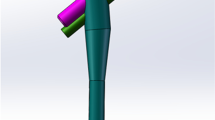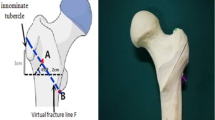Abstract
Purpose
The purpose of this study was to compare the biomechanical strength of the cephalomedullary nail InterTAN in cases of intertrochanteric fractures with the commonly used PFNA.
Methods
Sixteen fresh specimens of the proximal femur were used as intertrochanteric fracture models and were fixed using two fixation devices: the new proximal femoral nail (InterTAN) and proximal femoral nail antirotation (PFNA). An intertrochanteric fracture was created in composite bone models. Each specimen was loaded to simulate single leg stance while stiffness, migration (cut out), compressive force across the fracture site, and distal fragment rotation were monitored. The different internal fixation methods were tested by an experimental press analysis.
Results
Results of tests for femoral strength, stiffness, stability, and bearing capacity demonstrated that the biomechanical function of InterTAN was better than that of PFNA (P < 0.05). Compared with the PFNA nail, InterTAN showed increased strength, stiffness, and resistance torque of 30 %, 15 %, and 27 %, respectively.
Conclusion
Comparison of the treatment of intertrochanteric fractures with InterTAN and PFNA internal fixation showed that the InterTAN yielded improvement relative to the PFNA. InterTAN has a firmer and biomechanically superior performance and is therefore an ideal internal fixation method for treating intertrochanteric fractures. Additional research in osteopenic bone is necessary to comprehensively characterize the effects of the design enhancements of these two implants.








Similar content being viewed by others
References
Eberle S, Gerber C, von Oldenburg G et al (2010) A biomechanical evaluation of orthopaedic implants for hip fractures by finite element analysis and in-vitro tests. Proc Inst Mech Eng H 224:1141–1152
Magu NK, Tater R, Rohilla R et al (2008) Functional outcome of modified Pauwels’ intertrochanteric osteotomy and total hip arthroplasty in femoral neck fractures in elderly patients. Indian J Orthop 42:49–55
Strauss E, Frank J, Lee J et al (2006) Helical blade versus sliding hip screw for treatment of unstable intertrochanteric hip fractures: a biomechanical evaluation. Injury 37:984–989
Ruecker AH, Rupprecht M, Gruber M et al (2009) The treatment of intertrochanteric fractures: results using an intramedullary nail with integrated cephalocervical screws and linear compression. J Orthop Trauma 23:22–30
Fox KM, Magaziner J, Hawkes WG et al (2000) Loss of bone density and lean body mass after hip fracture. Osteoporos Int 11:31–35
Laursen JO (1999) Treatment of intracapsular fractures of the femoral neck in Denmark: trends in indications over the past decade. Acta Orthop Belg 65:478–484
Johansson T, Jacobsson SA, Ivarsson I et al (2000) Internal fixation versus total hip arthroplasty in the treatment of displaced femoral neck fractures: a prospective randomized study of 100 hips. Acta Orthop Scand 71:597–602
Rupprecht M, Grossterlinden L, Ruecker AH et al (2011) A comparative biomechanical analysis of fixation devices for unstable femoral neck fractures: the Intertan versus cannulated screws or a dynamic hip screw. J Trauma 71:625–634
Kristek D, Lovrić I, Kristek J et al (2010) The proximal femoral nail antirotation (PFNA) in the treatment of proximal femoral fractures. Coll Antropol 34:937–940
Liu Y, Tao R, Liu F et al (2010) Mid-term outcomes after intramedullary fixation of peritrochanteric femoral fractures using the new proximal femoral nail antirotation (PFNA). Injury 41:810–817
Sahin S, Ertürer E, Oztürk I et al (2010) Radiographic and functional results of osteosynthesis using the proximal femoral nail antirotation (PFNA) in the treatment of unstable intertrochanteric femoral fractures. Acta Orthop Traumatol Turc 44:127–134
Joseph TN, Al C, Kummer FJ et al (2002) The effect of posterior say on the fixation stability of intertrochantic hip fractures. J Trauma 52:544–547
Mellano D, Grosso E, Tarello M et al (2006) Hip fractures: our experience in surgical treatment. Minerva Ortop Traumatol 57:361–365
Banan H, Al-Sabti A, Jimulia T et al (2002) The treatment of unstable, extracapsular hip fractures with the AO/ASIF proximal femoral nail (PFN)–our first 60 cases. Injury 33:401–405
Hwang JH, Oh JK, Han SH, Shon WY et al (2008) Mismatch between PFNa and medullary canal causing difficulty in nailing of the pertrochanteric fractures. Arch Orthop Trauma Surg 128:1443–1446
Simmermacher RKJ, Ljungqvist J, Bail H et al (2008) The new proximal femoral nail antirotation (PFNA) in daily practice: results of a multicentre clinical study. Injury 39:932–939
Pu JS, Liu L, Wang GL et al (2009) Results of the proximal femoral nail anti-rotation (PFNA) in elderly Chinese patients. Int Orthop 33:1441–1444
Vicario C, Marco F, Ortega L et al (2003) Necrosis of the femoral head after fixation of trochanteric fractures with gamma locking nail. A cause of late mechanical failure. Injury 34:129–134
Seral B, Garcia JM, Cegonino J et al (2004) Finite element study of intramedullary osteosynthesis in the treatment of trochanteric fractures of the hip: Gamma and PFN. Injury 35:130–135
Lizhen W, Feng Z, Jingyun H (2012) Biomechanical study on proximal femoral nail antirotation(PFNA) for intertrochanteric fracture. J Mech Med Biol 12:1250075
Sitthiseripratip K, Van Oosterwyck H, Vander Sloten J et al (2003) Finite element study of trochanteric gamma nail for trochanteric fracture. Med Eng Phys 25:99–106
Kouvidis GK, Sommers MB, Giannoudis PV et al (2009) Comparison of migration behavior between single and dual lag screw implants for intertrochanteric fracture fixation. J Orthop Surg Res 4:16. doi:10.1186/1749-799X-4-16
Utrilla AL, Reig JS, Muñoz FM et al (2005) Trochanteric gamma nail and compression hip screw for trochanteric fractures: a randomized, prospective, comparative study in 210 elderly patients with a new design of the gamma nail. J Orthop Trauma 19:229–233
Lee PC, Hsieh PH, Chou YC et al (2010) Dynamic hip screws for unstable intertrochanteric fractures in elderly patients—encouraging results with a cement augmentation technique. J Trauma 68:954–964
Kraemer WJ, Hearn TC, Powell JN et al (1996) Fixation of segmental subtrochanteric fractures. A biomechanical study. Clin Orthop Relat Res 332:71–79
Rupprecht M, Grossterlinden L, Sellenschloh K et al (2011) Internal fixation of femoral neck fractures with posterior comminution: a biomechanical comparison of DHS® and Intertan nail®. Int Orthop 35:1695–1701
Zhang S, Zhang K, Jia Y et al (2013) InterTan nail versus Proximal Femoral Nail Antirotation-Asia in the treatment of unstable trochanteric fractures. Orthopedics 36:e288–e294
Zielinski SM, Meeuwis MA, Heetveld MJ et al (2013) Adherence to a femoral neck fracture treatment guideline. Int Orthop 37:1327–1334
Schneppendahl J, Grassmann JP, Petrov V et al (2012) Decreasing mortality after femoral neck fracture treated with bipolar hemiarthroplasty during the last twenty years. Int Orthop 36:2021–2026
Kannan A, Kancherla R, McMahon S et al (2012) Arthroplasty options in femoral-neck fracture: answers from the national registries. Int Orthop 36:1–8
Basso T, Klaksvik J, Syversen U et al (2012) Biomechanical femoral neck fracture experiments—a narrative review. Injury 43:1633–1639
Acknowledgment
This project was supported by “The Jinshan District Health Bureau Science Research Foundation (No. 2011-13)”.
Author information
Authors and Affiliations
Corresponding author
Additional information
Yanfeng Huang, Chunlin Zhang, Yi Luo are all co-first authors.
Rights and permissions
About this article
Cite this article
Huang, Y., Zhang, C. & Luo, Y. A comparative biomechanical study of proximal femoral nail (InterTAN) and proximal femoral nail antirotation for intertrochanteric fractures. International Orthopaedics (SICOT) 37, 2465–2473 (2013). https://doi.org/10.1007/s00264-013-2120-1
Received:
Accepted:
Published:
Issue Date:
DOI: https://doi.org/10.1007/s00264-013-2120-1




